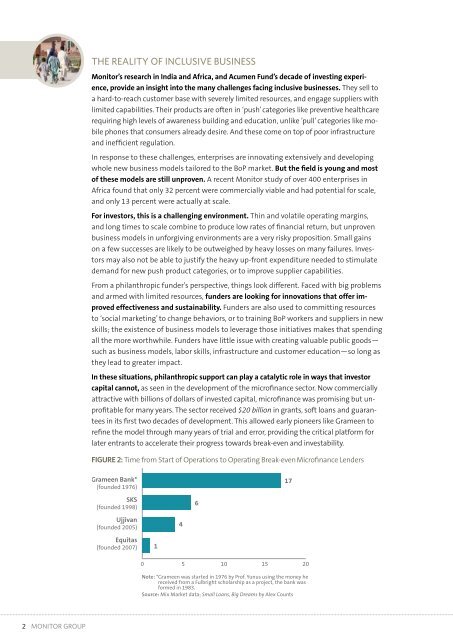FROm BluePRInT TO Scale - Monitor Inclusive Markets - Monitor ...
FROm BluePRInT TO Scale - Monitor Inclusive Markets - Monitor ...
FROm BluePRInT TO Scale - Monitor Inclusive Markets - Monitor ...
Create successful ePaper yourself
Turn your PDF publications into a flip-book with our unique Google optimized e-Paper software.
The Reality of <strong>Inclusive</strong> Business<br />
<strong>Monitor</strong>’s research in India and Africa, and Acumen Fund’s decade of investing experience,<br />
provide an insight into the many challenges facing inclusive businesses. They sell to<br />
a hard-to-reach customer base with severely limited resources, and engage suppliers with<br />
limited capabilities. Their products are often in ‘push’ categories like preventive healthcare<br />
requiring high levels of awareness building and education, unlike ’pull’ categories like mobile<br />
phones that consumers already desire. And these come on top of poor infrastructure<br />
and inefficient regulation.<br />
In response to these challenges, enterprises are innovating extensively and developing<br />
whole new business models tailored to the BoP market. But the field is young and most<br />
of these models are still unproven. A recent <strong>Monitor</strong> study of over 400 enterprises in<br />
Africa found that only 32 percent were commercially viable and had potential for scale,<br />
and only 13 percent were actually at scale.<br />
For investors, this is a challenging environment. Thin and volatile operating margins,<br />
and long times to scale combine to produce low rates of financial return, but unproven<br />
business models in unforgiving environments are a very risky proposition. Small gains<br />
on a few successes are likely to be outweighed by heavy losses on many failures. Investors<br />
may also not be able to justify the heavy up-front expenditure needed to stimulate<br />
demand for new push product categories, or to improve supplier capabilities.<br />
From a philanthropic funder’s perspective, things look different. Faced with big problems<br />
and armed with limited resources, funders are looking for innovations that offer improved<br />
effectiveness and sustainability. Funders are also used to committing resources<br />
to ‘social marketing’ to change behaviors, or to training BoP workers and suppliers in new<br />
skills; the existence of business models to leverage those initiatives makes that spending<br />
all the more worthwhile. Funders have little issue with creating valuable public goods—<br />
such as business models, labor skills, infrastructure and customer education—so long as<br />
they lead to greater impact.<br />
In these situations, philanthropic support can play a catalytic role in ways that investor<br />
capital cannot, as seen in the development of the microfinance sector. Now commercially<br />
attractive with billions of dollars of invested capital, microfinance was promising but unprofitable<br />
for many years. The sector received $20 billion in grants, soft loans and guarantees<br />
in its first two decades of development. This allowed early pioneers like Grameen to<br />
refine the model through many years of trial and error, providing the critical platform for<br />
later entrants to accelerate their progress towards break-even and investability.<br />
Figure TIME FROM 2: Time START from OF OPERATIONS Start of Operations <strong>TO</strong> OPERATING to Operating BREAK-EVEN Break-even – MICROFINANCE Microfinance LENDERS Lenders<br />
Grameen Bank*<br />
(founded 1976)<br />
17<br />
SKS<br />
(founded 1998)<br />
6<br />
Ujjivan<br />
(founded 2005)<br />
4<br />
Equitas<br />
(founded 2007)<br />
1<br />
0 5 10 15 20<br />
Note: *Grameen was started in 1976 by Prof. Yunus using the money he<br />
received from a Fulbright scholarship as a project, the bank was<br />
formed in 1983.<br />
Source: Mix Market data; Small Loans, Big Dreams by Alex Counts<br />
2<br />
MONI<strong>TO</strong>R GROUP

















